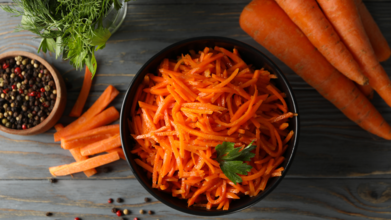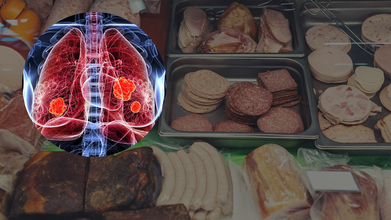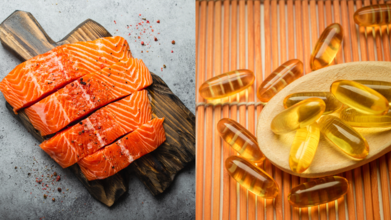- Health Conditions A-Z
- Health & Wellness
- Nutrition
- Fitness
- Health News
- Ayurveda
- Videos
- Medicine A-Z
- Parenting
- Web Stories
5 Natural Foods That Curb Hunger And Support Healthy Eating

Image Credit: Canva
People keep desiring a healthy weight; however, their journeys often are filled with temptation, hunger pangs, and the constant struggle with craving. Fortunately, nature provides some foods to reduce hunger and encourage more nutritious intake. These help decrease hunger while contributing to well-being in general. So, include these in your diet and manage your hunger naturally as you also opt for healthier choices.
In this article, we explore five natural foods that effectively reduce hunger and support healthy eating: high-fiber foods, fenugreek, chili peppers, lean proteins, and green tea. Together, these foods offer a combination of satiety-inducing properties and metabolic benefits, making them powerful tools in any weight management strategy.
1. High-Fiber Foods
Dietary fiber is one of the most effective natural appetite suppressants. Foods that are high in fiber take longer to digest, and the longer it takes to digest, the fuller you feel. Fiber adds bulk to your meals, slowing down the digestive process and keeping you satisfied longer. Furthermore, fiber regulates blood sugar levels, which prevents sharp spikes and crashes that trigger hunger cravings.
Approximately, there will be daily intake of 31g for men and 25g for women. Moreover, it is important that the fiber intake should always be increased gradually to help avoid digestive discomfort such as bloating and gas. Here are some high in fiber foods that can provide you with the needed input:
- Vegetables in the form of spinach and carrots
- Fruits in apples, pears, or berries
- Nuts as in chia seeds, almonds and even flaxseeds
- Legumes like lentils, beans, and chickpeas
- Whole grains, such as quinoa, oats, and brown rice
Add a mix of these fiber-rich foods into your daily diet can help control hunger and support healthy eating habits. Remember to drink plenty of water when increasing your fiber intake to keep things moving smoothly in your digestive system.
2. Fenugreek
Fenugreek (Trigonella foenum-graecum) is an herb in the legume family, which has been used for centuries in traditional medicine. Fenugreek seeds are a good source of soluble fiber and slow down digestion, and regulate blood sugar levels. It is one of the best herbs to be taken for appetite control.
It has been observed that fenugreek reduces both body mass index and waist circumference in patients with type 2 diabetes. A study demonstrated a notable decrease in BMI and waist size among subjects who consumed 5 grams of fenugreek powder twice daily before meals. Fenugreek increases feelings of fullness, thereby allowing the patient to spontaneously decrease total calorific intake.
Fenugreek can be added to the diet by including its seeds in salads, smoothies, or curries. One can also brew fenugreek tea. But care should be taken with the use of fenugreek supplements since their safety has not been well established. A healthcare provider must always be consulted before incorporating supplements of fenugreek into the diet, especially in those who have allergies to peanuts or chickpeas because fenugreek causes allergic reactions in some people.
3. Chili Peppers
Chili peppers, and particularly the compound capsaicin, boost metabolism and reduce appetite. Capsaicin is responsible for the pungency of chili peppers, which has been found to reduce hunger and increase satiety. One study concluded that the people who received chili peppers with their dinner felt more full and reduced their caloric intake by the evening hours, especially at dinner.
Inclusion of chili peppers in the diet may inhibit the craving to snack on later occasions, especially with high-calorie, high-fat foods. Capsaicin also supports fat burn by enhancing the calorie usage of the body. Research has shown that individuals consuming breakfast foods that contain chili peppers had reduced calorie consumption at lunch. This consumption was especially with fats and carbohydrates.
You can add fresh or dried chillies to soups and stews, stir-fries, and even salad. If you prefer not to have too much acidity, you can use powder cayenne pepper for a milder version of the spice. Be, however, cautious when it comes to quantity to not cause digestive discomfort.
4. Lean Protein
Protein is a strong anorexiant. The good sources of lean protein come from chicken, fish, tofu, eggs, and legumes that keep appetite in check due to inducing the release of hormones related to fullness and even suppressing the hormone ghrelin, responsible for increasing hunger. Adequate studies have shown the significant consumption of protein with resultant decreases in calorie intake and enhanced levels of satiety.
The recommended daily intake of protein varies according to the needs of the person, but it is estimated that for people who intend to lose weight or want to reduce hunger, approximately 30% of daily calorie intake should be acquired from protein. High-protein meals also contribute to fat loss and increased caloric burn since the body expends more energy digesting protein than fats or carbohydrates.
For example, add protein-rich foods to every meal, such as grilled chicken with quinoa, salmon with roasted vegetables, or plant-based tofu stir-fry. But be sure not to overdo it with the protein and neglect healthy fats, fruits, and vegetables in the process of maximizing the benefits of lean protein.
5. Green Tea
Green tea is a widely consumed beverage worldwide for its health benefits. It is especially known for its ability to help in weight management and appetite suppression. Green tea contains two key compounds—caffeine and catechins, particularly epigallocatechin gallate (EGCG)—that work together to boost metabolism and promote feelings of fullness.
Natural stimulant, caffeine will reduce hunger pangs, increase alertness; while EGCG will enhance burning of fat through stimulating the metabolism. According to different studies, green tea helps to regulate levels of hormones like leptin (fullness hormone) and decrease ghrelin (the hunger hormone), supporting the long-term regulation of appetite.
For best effects, it is recommended that individuals consume up to 8 cups of green tea in a day or at least 338 milligrams of green tea extract a day. However, consumption of excessive amounts should be avoided since very high levels of green tea extract might be harmful to the liver. People with liver problems must consult a doctor prior to taking green tea or extracts of green tea.
High-fiber foods, fenugreek, chili peppers, lean protein, and green tea are natural appetite suppressants that help nourish the body with all essential nutrients to sustain healthy lifestyles. Effective and easily sustainable, these foods do not only suppress your hunger but also improve your metabolic functions and overall health.
For maximum efficiency, integrate these foods with healthy behaviors like eating mindfully, drinking lots of water, and sleeping sufficiently. Appetite regulation needs to be consistent; this is a very easy process when right foods and life choices are used, making it simple to attain and maintain the healthy weight without having to go for drastic measures. Always seek medical professional advice when making radical dietary changes if you have medical conditions.
These natural appetite-suppressing foods will make you feel fuller, reduce your craving, and help you in making healthier choices toward the path of better health and well-being.
'Eat Your Skin Care' What This Online Trend Really Mean

Credits: Canva
It started with a simple TikTok video, four large carrots shaved into ribbons, mixed with garlic, sesame oil, lime juice, coconut aminos, rice vinegar, and green onions. The resulting “crunchy and addictive” salad quickly racked up millions of views under the viral trend #EatYourRetinol. But is it just social media hype, or can what’s on your plate really show up on your face?
The trend encourages eating vitamin A-rich foods, like carrots, to support skin health from the inside out. “Skincare always starts within,” says Johanna Salazar, registered dietitian nutritionist and founder of Healing Nutrition, as noted by Martha Stewart. But experts urge a balanced view: while diet can support your skin, it’s not a magic replacement for topical care.
What’s in the Carrot Salad That’s Good for Your Skin?
The base of the salad, carrots, are packed with beta-carotene, a precursor to vitamin A, known for boosting skin cell turnover and promoting a radiant complexion. Pairing it with a fat, like sesame oil, helps your body absorb the fat-soluble vitamin. Lime juice adds vitamin C, key for collagen production, while garlic and green onion offer prebiotics that support gut health, which in turn impacts skin health.
Sesame seeds sprinkled on top bring in vitamin E and fiber, which contribute to skin hydration and a healthy glow.
“It’s a nice mix of ingredients that all play small but beneficial roles in skin support,” says Salazar.
Dermatologists Weigh In: Not a Cure-All
Lauren Kole, M.D., associate professor of dermatology at the University of Alabama at Birmingham, appreciates the effort to eat for skin health—but with a word of caution.
“Deficiencies in certain vitamins and minerals can negatively affect the hair, skin, and nails,” she says. “But eating an excess doesn’t necessarily make your skin better.”
Kole points out that while beta-carotene from carrots is helpful, it's not strong enough to replace prescription retinol or other topical treatments for conditions like acne or hyperpigmentation. “Diet is not a substitute for proper skin care,” she emphasizes.
Beyond Carrots: Other Skin-Loving Foods
Experts agree that eating for your skin isn’t just about one salad. A variety of fruits, vegetables, and healthy fats are essential. Salazar and Kole both recommend incorporating:
Dark-colored fruits like berries and red grapes, which are high in antioxidants that fight oxidative skin damage.
Leafy greens such as spinach, kale, and chard, which are rich in vitamin C and help with collagen production.
Vegetables like broccoli, mushrooms, and cauliflower, which support healthy pigmentation and skin repair.
Healthy fats including avocados, walnuts, flaxseeds, and omega-3-rich foods to reduce inflammation and maintain skin moisture.
According to Kole, diets like the Mediterranean diet—rich in plant-based foods and good fats, have shown potential skin benefits in clinical settings.
Don’t Ditch Your Skincare Just Yet
While the “Eat Your Retinol” movement has its heart in the right place, Salazar and Kole stress that no food trend should replace professional skincare or personalized advice.
Lizzy Davis, Ph.D., a dietitian and assistant professor at UAB, advises people to approach such trends with balance.
“Cooking carrots, for example, doesn’t reduce their skin-friendly fiber,” she notes. “It can actually make them easier to digest and still beneficial.”
Davis also warns against over-relying on TikTok or Instagram for skincare advice. “Talk to your doctor or a registered dietitian,” she says. “Social media is convenient, but it can’t give you a plan tailored to your needs.”
Not Just Cigarettes, But Your Food Too Could Increase Your Chance Of Lung Cancer

Credits: Canva
We already know that ultraprocessed foods are linked to obesity, heart disease, and diabetes. But now, a new study published in the medical journal Thorax suggests a concerning addition to that list, lung cancer.
According to researchers, people who consume the highest amounts of ultraprocessed foods may face a 41% higher risk of being diagnosed with lung cancer, compared to those who eat the least, even when accounting for smoking and other known risk factors.
What Are Ultraprocessed Foods?
Ultraprocessed foods are industrial formulations made largely or entirely from substances not typically used in home cooking.
According to the Food and Agriculture Organization of the United Nations, these include artificial colorings, preservatives, emulsifiers, and chemically altered fats, sugars, or salts.
Common examples? Think sodas, chips, packaged soups, processed meats like chicken nuggets and cold cuts, instant noodles, diet soft drinks, and even some ice creams.
These additives enhance taste, shelf-life, and appearance, but at what cost?
What Does The Study Reveal About Food Choices and Lung Cancer Risk
Researchers behind the Thorax study analyzed data from over 100,000 adults who participated in the U.S. National Health and Nutrition Examination Survey. Each person filled out a detailed dietary questionnaire, which researchers then compared with medical records to track lung cancer diagnoses over time.
On average, people reported eating nearly three servings of ultraprocessed food a day, most commonly lunch meats and soft drinks.
Despite adjusting for smoking habits, age, sex, and other lifestyle factors, the study found a clear association between higher ultraprocessed food intake and increased lung cancer risk, particularly among people who had never smoked.
“This strongly suggests that these foods may contribute to lung cancer risk in ways beyond just smoking,” said Dr. David Katz, a specialist in preventive and lifestyle medicine and founder of the nonprofit True Health Initiative, as reported by CNN. Though not involved in the study, Katz called the findings “concerning and credible.”
Why Would Food Be Linked to Lung Cancer?
Experts believe multiple mechanisms could be behind the link.
“Industrial processing alters the food matrix,” the study authors explained, “which affects how nutrients are absorbed and may produce harmful contaminants.”
One such contaminant is acrolein. It is a toxic compound found not only in cigarette smoke, but also produced when cooking oils or fats are heated to high temperatures.
The U.S. Centers for Disease Control and Prevention (CDC) lists acrolein as a substance that can inflame and damage lung tissue.
Packaging may also be a problem. Plastics and synthetic materials used in food storage can leach chemicals, some of which are known or suspected carcinogens.
Add to that the fact that ultraprocessed foods are often low in omega-3 fatty acids, said Dr. Tom Brenna, professor of nutrition and chemistry at the University of Texas at Austin, as reported by CNN.
“Omega-3s spoil easily, so manufacturers tend to remove them to increase shelf life,” he explained. That’s unfortunate, because omega-3s help reduce inflammation, a key process in cancer development.
Smoking Isn’t the Only Risk Factor
Lung cancer remains one of the most commonly diagnosed cancers globally, with 2.4 million new cases in 2022, according to the World Health Organization. While smoking remains the leading risk factor, experts now believe diet and environmental exposures also play a role.
Dr. Fang Fang Zhang, a professor at Tufts University’s Friedman School of Nutrition Science and Policy, as reported by CNN, noted that while the study adjusted for smoking, the adjustment may not have been thorough enough. “Smoking needs to be measured more precisely, by cigarettes per day or years of exposure,” she said. Still, she found the link stronger in non-smokers, which makes the data all the more compelling.
What You Can Do: Eat More Whole Foods
The takeaway? While more research is needed to understand the exact biological mechanisms at play, the connection between ultraprocessed foods and cancer risk can no longer be ignored.
According to Dr. Katz, the solution lies in going back to basics. “Health and diet quality improve when people eat mostly whole, unprocessed foods,” he said, including vegetables, fruits, beans, whole grains, nuts, seeds, and other plant-based ingredients.
Dr. Zhang agrees. “Avoid foods with long ingredient lists full of unfamiliar chemicals,” she advised. “Focus on meals made from whole or minimally processed ingredients whenever possible.”
From PMS to Postpartum, Heart to Hormones: Why Fish Oil is the Ultimate Health Elixir for Every Woman at Every Stage

Fish oil is a star supplement loaded with omega-3 fatty acids like EPA and DHA. It offers a spectrum of vital benefits for women’s health. These extend beyond general well-being to support heart, brain and joint function, especially in areas of concern specific to women.
Fish oil, rich in omega-3s, addresses unique needs across all stages of a woman’s life. From adolescence through motherhood to menopause, fish oil supports cardiovascular, hormonal, mental and reproductive health.
A Boost for the Heart
Fish oil plays a major role in promoting heart health. According to Dr Mohit Bhatia, it helps lower triglyceride levels, a risk factor for cardiovascular disease, and improves blood flow, making it essential for proper cardiovascular function. He adds that it also slows the progression of cardiovascular disease.
Karan Khurana, a health expert at WishNew Wellness, concurs, saying that omega-3s in fish oil reduce triglycerides, lower blood pressure, and decrease arterial inflammation. This is particularly vital for post-menopausal women, who face a greater risk of heart disease. Regular consumption of fish oil, he says, can even lower the risk of heart attacks and strokes.
Hormones, Menstrual Cycles and PMS
Women facing bloating, mood swings or cramps may find some relief with fish oil. Dr Bhatia says that some evidence-based research suggests fish oil can help alleviate PMS and menstrual pain, thanks to its anti-inflammatory properties.
Khurana elaborates that omega-3s may regulate menstrual cycles and reduce cramps by lowering prostaglandin levels, which contribute to pain and inflammation. He adds that fish oil can ease common PMS symptoms such as bloating and breast tenderness.
Pregnancy, Postpartum and a Baby’s Brain
The benefits of fish oil carry into pregnancy too. Dr Bhatia points out the importance of DHA during this stage, saying it is vital for healthy foetal brain and eye development. It may also reduce the risk of preterm birth and help alleviate postpartum depression.
Khurana backs this up, pointing out that fish oil supplementation not only supports cognitive function in babies but also helps mothers manage postpartum depression. It plays a role in maintaining the mother’s brain health during and after pregnancy.
Bones, Joints and the Menopause Years
Post-menopause, bone health becomes a serious concern for many women. Dr Bhatia says that the anti-inflammatory properties of fish oil can contribute to bone health, potentially reducing the risk of osteoporosis.
Khurana adds that omega-3s enhance calcium absorption and support bone density. Fish oil, he explains, helps reduce inflammation linked to joint pain, promoting stronger bones and better mobility for older women.
Better Moods and Sharper Minds
Women are more likely than men to experience anxiety and depression, and fish oil might just help. Dr Bhatia explains that these fatty acids play a role in elevating mood and supporting brain function, potentially mitigating cognitive decline.
Khurana agrees, saying omega-3s support cognitive health and reduce the risk of dementia later in life. Fish oil, he says, may alleviate symptoms of depression and anxiety, contributing to overall mental well-being.
Your Skin Will Thank You Too
Dr Bhatia does not touch on it, but Khurana dives into skin benefits. He says that fish oil improves hydration, reduces wrinkles, and protects against UV damage. Its anti-inflammatory effects can ease conditions like eczema, making skin look and feel healthier.
Final Thoughts Before You Pop That Capsule
Dr Bhatia emphasises that while fish oil is a powerful supplement, it should complement a balanced diet and healthy lifestyle. He strongly recommends consulting a healthcare professional before starting, especially for those on medication or with existing conditions.
Khurana suggests aiming for 250–500 mg of combined EPA and DHA daily, either through fatty fish like salmon or through supplements. Fish oil, he concludes, is a holistic powerhouse that can help women thrive at every stage of life.
© 2024 Bennett, Coleman & Company Limited

